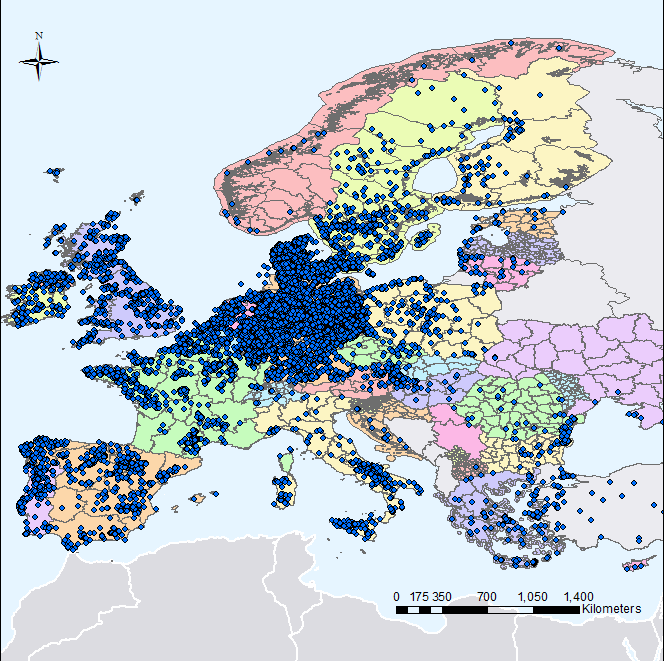Harnessing the Wind: Exploring Optimal Wind Farm Locations

Ever feel a strong gust of wind and think, "Wow, there's some serious power there"? That's the very essence of wind energy, and harnessing it effectively depends heavily on choosing the right spots for wind farms. The placement of these towering turbines isn't random; it's a complex process involving a careful balance of scientific analysis, environmental considerations, and community input.
Finding ideal wind farm sites is a bit like searching for the perfect apartment. You have a wishlist of must-haves: plenty of wind (obviously!), accessibility for maintenance, and minimal impact on the surrounding environment and residents. Then there are the nice-to-haves: proximity to existing infrastructure and supportive local policies. Just like apartment hunting, the perfect spot isn't always easy to find, but the rewards are worth the effort.
Historically, windmills have been used for centuries, harnessing wind power for tasks like grinding grain and pumping water. Modern wind farms, however, take this concept to a whole new level. These large-scale operations generate clean, renewable energy that can power entire communities. The strategic positioning of these farms plays a crucial role in their efficiency and overall impact.
The importance of thoughtful wind farm siting cannot be overstated. Choosing the right location can maximize energy production, minimize environmental disruption, and foster positive relationships with local communities. Poor siting, on the other hand, can lead to decreased energy output, conflicts with wildlife, and even pushback from nearby residents. It's a delicate balancing act with significant consequences.
A key factor in determining suitable wind farm locations is wind resource assessment. This involves measuring wind speed, direction, and consistency over time. Sophisticated tools, like meteorological masts and remote sensing technologies, gather data to create detailed wind maps, helping developers pinpoint areas with the highest wind potential.
The history of wind farm siting has evolved significantly. Early wind turbines were often placed based on readily available land and basic wind observations. Today, the process is far more sophisticated, incorporating advanced modeling techniques, environmental impact assessments, and extensive community consultations.
Choosing the right location can maximize energy production. For example, offshore wind farms, situated in areas with consistent and powerful winds, can generate significantly more energy than onshore farms. Proper siting also minimizes environmental disruption by avoiding sensitive habitats and migratory routes for birds and bats.
A major challenge in wind farm siting is balancing the need for clean energy with potential environmental impacts. Thorough environmental impact assessments are crucial to identify and mitigate risks to wildlife, particularly birds and bats. Careful planning and the implementation of mitigation measures, such as radar detection systems to curtail turbine operation during peak bat activity, are essential for responsible wind energy development.
Advantages and Disadvantages of Different Wind Farm Locations
| Location Type | Advantages | Disadvantages |
|---|---|---|
| Onshore | Lower construction costs, easier access for maintenance | Visual impact, land use conflicts, variable wind resources |
| Offshore | Higher wind speeds, less visual impact | Higher construction costs, more complex maintenance, potential marine ecosystem impacts |
Best Practices for Wind Farm Siting:
1. Conduct thorough wind resource assessments using advanced meteorological tools.
2. Perform comprehensive environmental impact studies to minimize ecological disruption.
3. Engage with local communities early and often to address concerns and build consensus.
4. Utilize advanced modeling techniques to optimize turbine placement and maximize energy output.
5. Consider proximity to existing transmission infrastructure to reduce costs and minimize environmental impact.
Frequently Asked Questions:
1. How is wind farm location determined? - Through wind resource assessment and environmental impact studies.
2. Do wind farms affect wildlife? - Yes, but careful planning and mitigation measures can minimize risks.
3. What are the benefits of offshore wind farms? - Higher wind speeds and less visual impact.
4. How do wind farms impact local communities? - Can create jobs and generate revenue, but also raise concerns about visual impact and noise.
5. What is the future of wind farm siting? - Continued advancements in technology and increased focus on community engagement.
6. How are wind turbines placed within a wind farm? - Strategically to maximize energy capture and minimize turbulence.
7. What factors determine the size of a wind farm? - Available land area, wind resources, and energy demand.
8. How are noise impacts from wind farms addressed? - Through careful siting and noise mitigation technologies.
Tips and Tricks for understanding wind farm siting include researching local wind resources, attending community meetings, and exploring online resources about wind energy development.
In conclusion, the locations of wind farms are carefully chosen through a complex process involving scientific analysis, environmental considerations, and community engagement. From the initial wind resource assessment to the final turbine placement, every step is crucial to maximizing energy output while minimizing negative impacts. Understanding the factors that influence wind farm siting empowers us to appreciate the intricate balance required to harness this clean, renewable energy source effectively. The future of wind energy hinges on our ability to continue refining siting practices, incorporating technological advancements, and fostering open communication with communities. As we look towards a more sustainable energy future, thoughtful wind farm placement will play a pivotal role in powering our homes and businesses while preserving the planet for generations to come. Let's embrace the power of the wind and work together to build a cleaner, greener future.
Exploring cardrona is it a wine variety
The intricate narrative of hood money tattoo designs
Unlocking the secrets of shadow slave light novel chapter 1053











